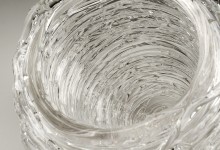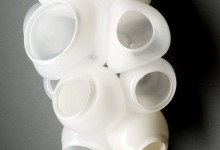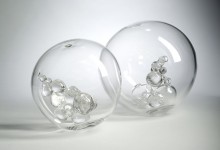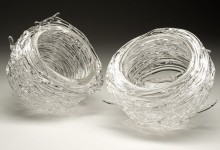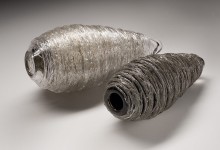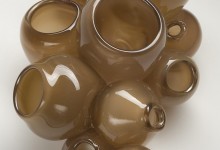Text by James D. Campbell
Julia Reimer’s glass works wed refreshing simplicity with exquisite formal refinement. They possess a beguiling eloquence that is at once the product of her imagination and the landscape she grew up in. Her work is infused with a specifically Prairie light and have a reductive ethos. Seldom, if ever, baroque, her forms bespeak a stoicism that is more ecstatic than pragmatic. I mean, they have pure joy in them, even as they inspire reflection.
Reimer is a true savant when it comes to seductive forms that are imbued with a luminosity almost magical in its mien. This luminosity is inborn and reminds me of nephrite mutton fat carvings dating from the Chinese Qianlong Dynasty (the 1780s). But, notably and remarkably, her creations are made out of glass, not jade.
Furthermore, her works have a minimalist tendency very much in keeping with the landscape she knows best. She has often spoken of how her designs are directly inspired by the landscape of her childhood home in the foothills of the Rocky Mountains in southern Alberta. She has said: “That’s where I acquired an appreciation for the crisp prairie light, and the undulating hills and grasslands carved by wind and water that influence my artistic vision”. Born from nature, nurtured in memory, fired in the alembic of her imagination, her glass inventions are overwhelmingly seductive. So her stoicism also has its sensuous counterpart. She has said: “My love of the landscape has led to an aesthetic based on beautiful simplicity of form and light.” This aesthetic is wholly and uniquely her own. She is a magician in capturing light, and making the glass that its vessel and conduit modern in design and almost primordially tonal and expressive in material presence. Indeed, these phenomenal creations in blown glass find worthy antecedents in stark bronze Tibetan singing bowls and 14th-century Vietnamese celadon glazed bowls.
It has been said that when Julia Reimer was first initiated into the craft of glass blowing, she instinctively knew she had discovered the ideal medium for expressing her creativity. She says, “I was always drawn to the muted luminescence of river ice on bright brisk days in winter. So when I had a chance to combine the essence of light, color and movement with a material, it was a perfect fit.” A perfect fit, indeed, for she has become the foremost magician of light working in the medium of glass.
Her original design sensibility and technical virtuosity have been recognized through several awards and scholarships and general acclaim, but is demonstrated, above all, in the works she is showing now at Art Mur.








